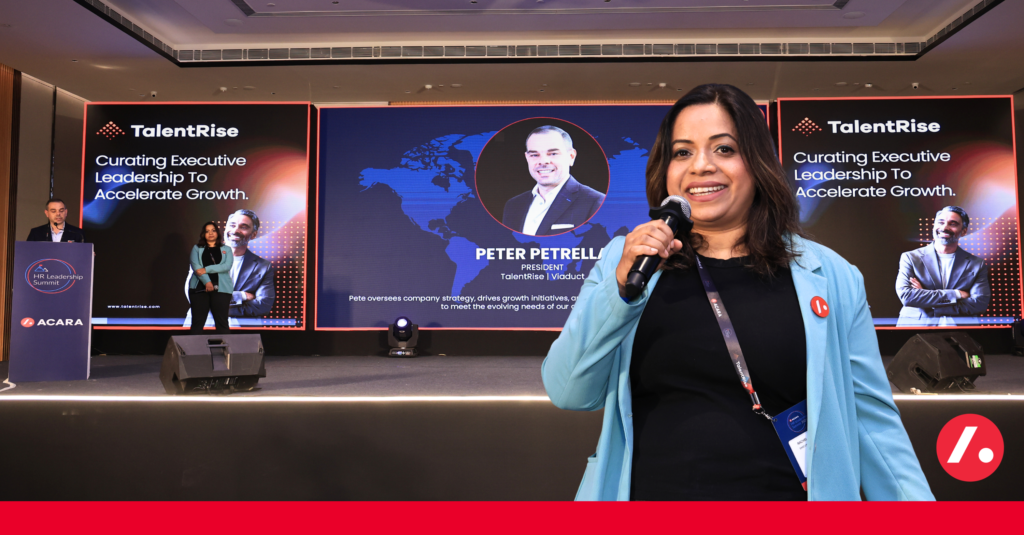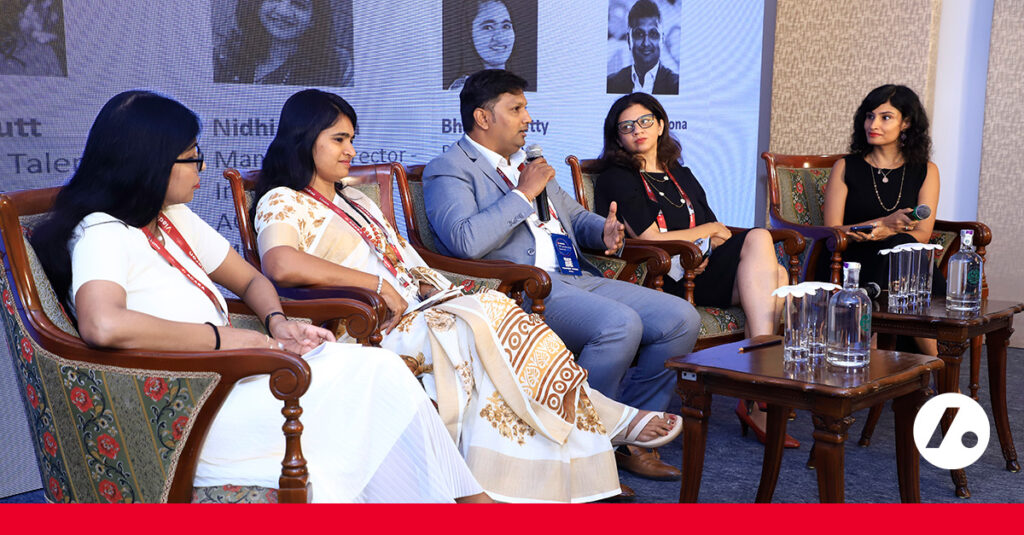
From Coaching to Culture: 4 Powerful Conversations That Shaped the 2025 HR Leadership Summit
Acara India’s 2025 HR Leadership Summit in June delivered critical insights into the evolving landscape of human resources, organizational development, and strategic workforce management. The event brought together industry leaders to address pressing challenges and emerging opportunities that define modern workplace dynamics.
Four key panel discussions emerged as particularly significant in shaping our understanding of HR’s strategic role in driving organizational success.
Global Capability Centers: Redefining India’s Role in Innovation
The opening panel examined whether India’s Global Capability Centers (GCCs) have evolved beyond their traditional cost-arbitrage model to become genuine innovation drivers. The evidence presented was compelling and definitive.
Strategic transformation industry leaders from Amadeus, ZEISS, and other organizations demonstrated how their India operations now lead global initiatives across AI-driven personalization, cybersecurity infrastructure, and digital transformation. The shift represents a fundamental change from execution-focused roles to strategy-shaping capabilities.
As one global COO noted, “We’re not here to build a Navy, but a team of Navy SEALs,” emphasizing the transition from scale-based to skill-based value creation.
Key Performance Indicators
- Over 1,800 GCCs currently operate in India, employing 1.9 million professionals
- Projected 2x growth within the next five years
- Contribution to India’s GDP expected to increase from 2% to 5%
- ER&D product organizations showing 40% CAGR growth compared to 10% for traditional GCC models
Success Factors
The panel identified several critical elements for GCC evolution:
- Empowered local leadership with decision-making authority
- Clear value proposition alignment between parent organizations and India centers
- Investment in specialized talent development
- Cultural transformation from pseudo-ownership to genuine value ownership
Case Study: Lowe’s India Innovation
A six-engineer team developed a multi-million-dollar media monetization platform during the pandemic, demonstrating the shift from directive-based work to opportunity-driven innovation. This example illustrates how GCCs are increasingly contributing to core business value creation rather than peripheral support functions.
Executive Integration: Addressing the Productivity Gap
President Pete Petrella and master coach Rachel Gojer presented compelling research on executive integration challenges and solutions through their methodology.
The Challenge
Research indicates that 60% of new executives require over six months to reach full productivity, with many never achieving complete integration. This represents a significant organizational cost in terms of lost productivity, missed opportunities, and potential executive failure.
The Solution Framework
TalentRise’s coaching model addresses integration through four strategic pillars:
- Growth Mindset Development – Facilitating adaptive thinking and continuous learning orientation
- Stakeholder Relationship Building – Creating systematic approaches to internal network development
- Cultural Alignment – Ensuring executive behaviors align with organizational values and practices
- Trust Establishment – Building credibility and influence within existing organizational structures
Implementation Approach
The session demonstrated practical application through experiential learning, allowing participants to reflect on their own integration experiences and identify systemic improvement opportunities. This methodology transforms executive onboarding from an administrative process to a strategic investment.
Business Impact
Organizations implementing structured integration coaching report faster time-to-productivity, improved executive retention rates, and enhanced organizational performance during leadership transitions.
Mental Health in the Workplace: Moving Beyond Compliance
The mental health panel, featuring leaders from T-Systems, Goavega, Royal Cyber, and other organizations, addressed the gap between organizational mental health initiatives and actual employee well-being outcomes.
Current State Assessment
Panel discussions revealed significant challenges in existing mental health support systems:
- Employee Assistance Programs (EAPs) are often underutilized due to trust and stigma concerns
- Digital burnout is increasing across all organizational levels
- Middle management is experiencing heightened stress while serving as the primary support system
- Generational differences in mental health expectations and communication preferences
Strategic Recommendations
The panel emphasized moving beyond performative wellness programs to implement substantive cultural changes:
Immediate Actions:
- Implement regular digital detox protocols
- Customize wellbeing programs for different personality types and generational preferences
- Provide comprehensive manager training on psychological safety and supportive leadership
- Establish transparent communication channels for mental health concerns
Long-term Culture Development:
- Create psychologically safe environments where mental health discussions are normalized
- Develop measurement systems for the well-being program effectiveness
- Integrate mental health considerations into performance management systems
- Build organizational resilience through proactive stress management initiatives
Key Insight: As one panelist noted, “Your mental well-being is directly proportional to my productivity,” highlighting the direct business impact of employee mental health on organizational performance.
Generation Z Integration and AI Workplace Transformation
The final panel addressed the convergence of generational workforce changes and artificial intelligence implementation, examining how organizations can effectively navigate both trends simultaneously.
Generation Z Workplace Expectations
Research presented during the panel revealed distinct generational preferences:
- Preference for immediate, transparent communication
- Value alignment between personal and organizational purpose
- Expectation of flexible work arrangements as standard practice
- Focus on skill development and career impact over traditional hierarchical advancement
- Preference for upfront compensation rather than long-term incentive structures
AI Integration Challenges
The panel identified a critical paradox: while millions of graduates remain unemployed, AI and data science roles experience significant talent shortages. This highlights the urgent need for proactive workforce planning and skill-development initiatives.
Strategic Response Framework
Organizations are implementing several approaches to address these challenges:
- Proactive Role Mapping – Identifying future skill requirements and developing transition pathways
- Cross-functional Collaboration – Breaking down departmental silos to enable rapid skill transfer
- Balanced Talent Strategy – Combining external hiring with internal upskilling programs
- Technology-enabled Learning – Leveraging AI tools for personalized skill development
Best Practice Example: Tata IQ’s initiative to provide free GenAI training to students and professionals demonstrates how organizations can contribute to workforce development while building future talent pipelines.
HR Strategic Evolution
The panel emphasized HR’s evolving role in embedding within business units to understand changing role requirements and proactively address workforce transformation needs.
Strategic Implications for HR Leadership
The 2025 HR Leadership Summit reinforced HR’s transition from a support function to a strategic business driver. Key imperatives for HR leaders include:
- Organizational Agility
- Develop flexible talent strategies that can adapt to rapid market changes
- Implement personalized approaches to employee development and engagement
- Create organizational structures that support innovation and rapid decision-making
- Strategic Investment in Human Capital
- Prioritize executive integration and leadership development programs
- Invest in comprehensive coaching and mentoring systems
- Develop succession planning that emphasizes internal capability building
- Culture and Wellbeing Integration
- Build inclusive workplace cultures that support mental health and psychological safety
- Implement measurable wellbeing programs that drive business outcomes
- Create environments where diverse generational preferences can coexist effectively
- Future-focused Workforce Planning
- Develop AI integration strategies that enhance rather than replace human capabilities
- Create upskilling programs that address emerging technology requirements
- Build partnerships with educational institutions and training providers
- Performance and Purpose Alignment
- Balance short-term performance requirements with long-term organizational purpose
- Create meaningful work experiences that attract and retain top talent
- Develop measurement systems that capture both business and human outcomes
Conclusion
The 2025 HR Leadership Summit provided a comprehensive framework for understanding and addressing the complex challenges facing modern organizations. The integration of technological advancement, generational change, and evolving business requirements demands strategic HR leadership that goes beyond traditional functional boundaries.
Success in this environment requires HR professionals to develop a sophisticated understanding of business strategy, human psychology, and technological capability while maintaining focus on fundamental human needs for purpose, growth, and well-being.
The path forward involves continuous learning, adaptive strategy development, and unwavering commitment to creating workplaces that enable both organizational success and human flourishing.
For additional insights from the 2025 HR Leadership Summit, including panel recordings and supplementary materials, please visit our social accounts. Connect with our team to explore how these strategic frameworks can be implemented within your organization.




